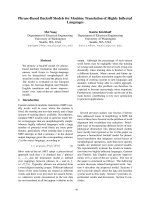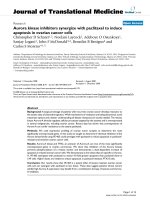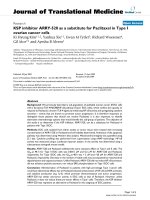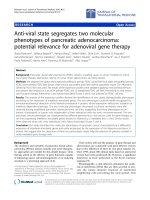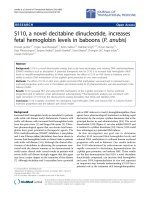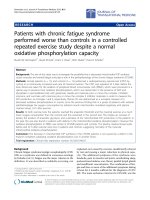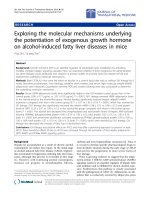báo cáo hóa học: " PLGA-based gene delivering nanoparticle enhance suppression effect of miRNA in HePG2 cells" docx
Bạn đang xem bản rút gọn của tài liệu. Xem và tải ngay bản đầy đủ của tài liệu tại đây (1.14 MB, 9 trang )
NANO EXPRESS Open Access
PLGA-based gene delivering nanoparticle
enhance suppression effect of miRNA in
HePG2 cells
Gao Feng Liang
†
, Yan Liang Zhu
†
, Bo Sun, Fei Hu Hu, Tian Tian, Shu Chun Li and Zhong Dang Xiao
*
Abstract
The biggest challenge in the field of gene therapy is how to effectively deliver target g enes to special cells. This
study aimed to de velop a new type of poly(D,L-lactide-co-gl ycolid e) (PLGA)-based nanoparticles for gene
delivery, which are capable of overcoming the disadvantages of polyethylenimine (PEI)- or cationic liposome-
based gene carrier, such as the cytotoxicity induced by excess positive charge, as well as the aggregation on
the cell surface. The PLGA-based nanoparticles presented in this study were synthesized by emulsion
evaporation method and characterized by transmission electron microscopy, dynamic light scattering, and
energy dispersive spectroscopy. The size of PLGA/PEI nanoparticles in phosphate-buffered saline (PBS) was about
60 nm at the optimal charge ratio. Without observable aggregation, the nanoparticles showed a better
monodispersity. The PLGA-based nanoparticles were used as vector carrier for miRNA transfection in HepG2
cells. It exhibited a higher transfection efficiency and l ower cytotoxicity in HepG2 cells compared to the PEI/
DNA complex. The N/P ratio (ratio of the polymer nitrogen to the DNA phosphate) 6 of the PLGA/PEI/DNA
nanocomplex displays the best property among various N/P proportions, yielding similar transfection efficiency
when compared to Lipofectamine/DNA lipoplexes. Moreover, nanocomplex shows better serum compatibility
than commercial liposome. PLGA nanocomplexes obviously accumulate in tumo r cells after transfection, which
indicate that the complexes contribute to cellular uptake of pDNA and pronouncedly enhance the treatment
effect of miR-26a by inducing cell cycle arrest. Therefore, these results demonstrate that PLGA/PEI nanoparticles
are promising non-viral vectors for gene delivery.
Introduction
MicroRNAs (miRNAs) are small, highly conserved, non-
coding RNAs that regulate gene expression at the post-
transcriptional level. They involve in various cellular
mechanisms including development, differentiation, pro-
liferation, and apoptosis. The pivotal roles of these miR-
NAs in human cancers have been discovered [1,2], and
the therapeutic applications of miRNA have been devel-
oped using various viral vectors [3,4].
However, the disadvantages of viral vectors limited
their application in gene delivery, such as immu nogenic/
inflammatory responses, low loading capacity, large scale
manufacturing, and quality control [5]. Consequently,
more attention have been paid on non-viral gene delivery
vectors in recent years, such as liposomes (lipoplexe s),
polycationic polymers (polyplexes), and organic or inor-
ganic nanoparticles (nan oplexes) [6]. To enhance gene
delivery effect, various cationic complexes have been
developed for delivering plasmid DNA, a ntisense, or
siRNA into cells [7-9]. Poly(D,L-lactide-co-glycolide)
(PLGA) were extensively assessed for their abili ty of deli-
vering variety of therapeutic agents [10-12]. PLGA nano-
particles were shown to escape from the endo-lysosomal
compartment to the cytoplasmic compartment and
release their contents over extended periods of time [13].
These features rendered PLGA nanopartic les as potential
tool for gene delivery efficiently.
Polyethylenimine (PEI) is water-soluble, linear, or
branched polymers with a protonable amino group [14,15].
Due to their high cationic charge density at physiological
pH, PEIs are able to form non-covalent complexes with
DNA, siRNA, and antisense oligodeoxynucleotide.
* Correspondence:
† Contributed equally
State Key Laboratory of Bioelectronics, School of Biological Science and
Medical Engineering, Southeast University, Nanjing, 210096, China
Liang et al. Nanoscale Research Letters 2011, 6:447
/>© 2011 Liang et al; licensee Springer. This is an Open Access article distributed under the terms of the Creative Commons Attribution
License ( which permits unrestricted use, distribution, and reproduction in any medium,
provided the original work is properly cited.
Therefore, PEIs hold a prominent position among the
polycationic polymers used for gene delivery [16-18]. The
intracellular release of PEI/nucleic acids co mplex es from
endosomes is considered as relying on the protonation of
amines in the PEI molecule, which leading to osmotic
swelling and subsequent burst of the endosomes. More-
over, PEIs also facilitate nucleic acid entry into the nucleus
[19,20]. However, it has been reported that long PEI chains
arehighlyeffectiveingenetransfection,butmorecytotoxic
[14,21,22].
In order to overcome these hurdles in gene therapy
and improve gene delivery efficiency, we developed
novel non-liposome-based cationic polymers which are
composed of PLGA as the core and cationic PEI as the
shell. The biodegradable PLGA nanoparticles, modified
with a polyplexed PEI coating, were tested by loading
the expression vector (pDNA) of miR-26a, which is cap-
able of indu cing cell cycle arrest in HepG2 cells. In this
study, nanoparticles of controlled size and persistent
shape have been obtained by an emulsion evaporation
method and characterized by transmission electron
microscopy (TEM), dynamic light scattering (DLS), and
energy dispersiv e spectroscopy (EDS). The nanoparticles
have been determined by their physicochemical and bio-
logical properties. The formulated nanoparticles enhance
cellular uptake of miRNA, pronounce upregulation of
miR-26a, induce cell cycle arrest, and improve gene
expression activity compared with PEI and commercial
liposome. Furth ermore, these particles can be easily fab-
ricated and have a high transfection efficiency and low
cell toxicity. Our results suggest a new approach for
miRNA delivering by PLGA/PEI nanoparticles in gene
therapy.
Materials and methods
Materials
Branched PEI (M
W
, 25 kDa) and poly(vinylalcohol)
(PVA) were obtained from Sigma Aldrich (St. Louis,
MO, USA). D,L-Lactide/glycolide copolymer (PLGA,
lactic/glycolic molar ratio: 53/47; M
W
, 25 kDa) was pur-
chased from Daigang Chemical Reagent Co., Ltd. (Jinan
City, Shandong Province, China). Dulbecco’ s modified
Eagle’s medium (DMEM), fetal bovine serum (FBS),
penicillin-st reptomycin, tryp sin, and Dulbecco’ sPBS
were purchased from Invitrogen (Carlsbad, CA, USA),
and pGFP-miRNA plasmid was constructed according
to the methods described pr eviously [23]. Other
reagents were of analytical grade obtained from suppli-
ers and used without purification.
PLGA/PEI nanosphere synthesis
PLGA nanospheres were obtained by using water-in-oi l-
in-water solvent evaporation technique as described pre-
viously [24]. Briefly, 150 mg of PLGA polymer was
dissolved in 1.5 ml of dichloromethane to yield a 10%
( w/v) polymer solution. After 3 ml of a 7% (w/v)aqu-
eous solution of PVA was added to the organic phase
and emulsified at 10,000 × g using a homogenizer for 5
min. The resulting double emulsion was then poured
into 50 ml of a 1% PVA sol ution and emulsified for 15
min. This resulted in the form atio n of a water/oi l/water
emulsion that was stirred for at least 12 h at room tem-
perature, allowing the methylene chloride to evaporate.
The resulting microspheres were washed twice in deio-
nized water by centrifugation at 16,000 × g and freeze-
dried.
Then, PEI aqueous solution was added in the afore-
mentioned PLGA nanoparticle suspension, and incu-
bated fifteen minutes.
Nanoparticle characterization
PLGA nanoparticles, PLGA/PEI nanoparticles, and
PLGA/PEI /pDNA complexes mean hydrodynamic dia-
meters measurements were conducted b y using Nano
Particle Analyzer (Bec kman Coulter, Fullerton, CA,
USA). The mean hydrodynamic diameter was deter-
mined via cumulative analysis.
The zeta-potential (surface charge) of the polymers
and polyplexes was determined at 25°C with a scattering
angle of 90° using potential measurement analyzer (90
PLus,Brookhaven,Holtsville,NY,USA).Sampleswere
prepared in PBS and diluted with deionized water to
ensure that the measurements be performed under con-
ditions of low ionic strength where the surface charge of
the particles can be measured accurately.
The particle size and morphology of the PLGA nano-
particles, PEI-modified PLGA nanoparticles, and PEI-
modified PLGA nanoparticles/miRNA complexes were
characterized via transmission electron microscope
(TEM, JEM-2100, JEOL, Tokyo, Japan).
Energy dispersive spectroscopic analysis (Oxford EDS,
Oxford Instruments, Oxon, UK) was employed to per-
form the quantitative elemental analysis of the
nanocomplex.
Measurement of the interactions between miRNA and
nanoparticles
Complexes were formed by diluting miRNA expression
vector (pDNA) and the different amount of nanoparti-
cles separately with 0.9% NaCl (pH 7.4). The nano parti-
cles at different concentrations were added to 1 μg
green fluorescent protein(pPG-eGFP-miR) (GFP)-
encoded miRNA vect or solution, vortexed immediately
at room temperature, and allowed to stand for 30 min
to form PLGA/PEI/pDNA complexes. Then, the com-
plexes were submitted to electrophoresis in 1%/TAE
agarose gel at 90 V for 60 min. Images were acquired
using a PeiQing gel imaging system (PeiQing, Shanghai
Liang et al. Nanoscale Research Letters 2011, 6:447
/>Page 2 of 9
City, China). GelRed (Biotium, Hayward, CA, USA), an
ultra sensitive nucleic acid dye, was used to examine the
interactions of DNA with the nanocomplex to deter-
mine optimal N/P ratio of the nanocomplex [25].
Cytotoxicity studies
HepG2 (human hepatocellular carcinoma cell) cells were
cultured in D MEM supplemented with 10% FBS, strep-
tomycin at 100 μg/mL, and penicillin at 100 U/mL.
Cells were maintained at 37°C in humidified and 5%
CO
2
incubator. The cytotoxicity of PL GA/PEI nanopar-
ticles, complexed with or without pDNA, was deter-
mined in a separate set of experiments using MTT assay
to detect changes in cell viability after an incubation
time of 24 h. Cells were seeded in 24-well plates at an
initial density of 2 × 10
4
cells/well for HepG2 in 0.5 mL
of growth medium and incubated for 24 h prior to the
addition of PLGA/PEI and PLGA/PEI/DNA at different
N/P ratio. Untreated cells were taken as control with
100% viability. Triton X-100 1% (SPI Supplies, West
Chester, PA, USA) was used as positive control of
cytotoxicity.
In vitro gene transfection and quantification study
Before GFP transfection assay, cells were seeded in 24-
well plates at a density dependent of the cell line in
DMEM with 10% FBS. When the cells were at 50% to
70% confluence, the medium in each well was replaced
with fresh normal medium or medium containing naked
pGFP, lipo2000, or PLGA/PEI/DNA complex under
standard incubator conditions. After 48 h, cells harbor-
ing an expressing integrant were viewed by fluorescence
microscopy based on GFP.
The analysis of transfection efficiency was performed
using a flow cytometer (BD Biosciences, Mountain
View, CA, USA). Cells were first washed with PBS and
detached with 0.2 mL of 0.25% trypsin. Growth medium
was then added, and the cells suspension was centri-
fuged at 1,000 rpm for 5 min. Two further cell-washing
cycles of resuspension and centrifugation was carried
out in PBS before fixation in 0.4 mL of 75% ethanol.
The percentage of cells expressing GFP was then deter-
mined from 10,000 events and reported as a mean ±
standard deviation (SD) of three samples.
miRNA expression and cell cycle study
Gene-specific primers and reverse transcriptase were
used to convert mature miRNA to cDNA [26], DNase-
treated total RNA (20 μl of total volume) was incubated
with 1 μl of 10 mM reverse transcription primers listed
in Table 1 . The reaction was h eated to 80°C for 5 min
to denature the RNA and then cooled to room tempera-
ture quickly, after that the remaining reagent s (5 × buf-
fer, primescript RTase (TaKaRa, Dalian, China), dNTPs,
DTT, and RNase inhibitor(SunshineBio, Nanjing, China)
were added as specified according to th e manufacturer’s
protocol. The reaction proceeded for 45 min at 42°C fol-
lowed by 5 min incubation at 85°C to inactiva te the
reverse transcriptase. cDNA may be stored at -20°C or
-80°C.
Then, real-time quantitative polymerase chain reaction
(PCR) was performed to evaluate miR-26a expression in
HepG2 cells after 3 days transfection using standard
protocols on an A pplied Biosystems 7500 Sequence
Detection System (Applied Biosystems, Foster City, CA,
USA).Briefly,1.25μl of cDNA was added to 10 μlof
the 2 × SYBR green PCR master mix (TaKaRa, Dalian,
Chi na), 200 nM of each primer and water to 20 μl. The
reactions were amplif ied for 15 s at 95°C a nd 1 min at
60°C for 40 cycles. The thermal denaturation protocol
was run at the end of the PCR to determine the number
of the products that were present in the reaction. Reac-
tions are typically run in triple. The cycle number at
which the reaction crossed an arbitrarily placed thresh-
old (C
t
) was determined for each gene and the relative
amount of each miRNA. Target gene expression was
normalized to the expression of the housekeeping gene
U6 for each sample. Data were analyzed using the
2
−C
t
method [27].
Cell cycle profiles of nanoparticles transfected HepG2
cells were performed using a FACS Calibur and with
CellQuest™ software (BD Biosciences, Mountain View,
CA, USA). HepG2 cells (5 × 10
4
per well) were seeded
into 24-well plates. Cells were treated with different for-
mulations at a concentration of 1 μg miRNA in serum
containing medium at 37°C for 72 h. Cells were washed
once with PBS and then fixed in 75% ethanol and, after
fixation, stained with PI according to manufacturer’ s
instructions.
Statistical analysis
All statistical analyses were performed by Student’s t
test. Data were expressed as means ± SD. Results were
considered statistically significant when the p value was
less than 0.05.
Results and discussions
Particle size and surface morphology of the nanoparticles
Particle size and zeta potential have been demonstrated
to play important roles in determining the level of cellu-
lar and tissue uptake; researchers have also conducted
to investigate the size effect on the gene delivery effi-
ciency. PLGA nanoparticles with smaller size below 100
nm have been proved to gain higher gene transfection
efficiency than those of 200 nm [28,29].
In this study, PLGA-based nanoparticle was developed
and characterized using TEM, DLS, and EDS. Figure 1
showed different characteristics of PLGA nanoparticles
Liang et al. Nanoscale Research Letters 2011, 6:447
/>Page 3 of 9
with PEI or PEI/pDNA. The diameter of the nanoparti-
cles/DNAcomplexesrangedfrom45to70nmatthe
determined nanoparticles/DNA N/P ratios. Slight size
changes were observed following coating of the biode-
gradable PLGA nanoparticles with PEI or PEI/pDNA.
The mean diameter of the sole PLGA nanoparticles was
approximately 50 nm, whereas the sizes of complexed
PLGA nanoparticles containing PEI or PEI/pDNA are
increased to about 57 or 60 nm, respectively. These
results are consistent with our DLS observations and
indicate that the PLGA nanoparticle size may be
increased with PEI or polyplexed PEI/pDNA coating.
Zeta potential is an indicator of the surface charge of
nanoparticles/DNA complexes. The positive charges on
the surface of the complexes can help the nanoparticles
bind tightly to the negatively charged cellular mem-
brane, therefore facilitating their entry into the cells by
endocytosis. In this study, zeta potential values of the
PLGA nanoparticles and PLGA/PEI nanoparticle and
PLGA/PEI/pDNA complexes (at various N/P rati os ran-
ging from 1 to 10) were measured. The values of the
PLGA nanoparticles, PLGA/PEI nanoparticles, and
PLGA/PEI/pDNA complexes are -21.4, 29.4, and 23.7
mV, respectively. As shown in Table 2, the pure PLGA
nanoparticles represent negative potential due to the
existence of carboxyl. PEI is postulated on the surface of
PLGA nanoparticles due to the electrostatic interaction
of cationic PEI molecules with anionic PLGA polymers.
Introduction of PEI increase significantly the zeta poten-
tial of the nanoparticles. Again, pDNA are adsorbed on
the surface of PLGA/PEI nanoparticles due to the elec-
trostatic interaction of negatively charged pDNA with
positively charged PLGA/PEI nanoparticles. The zeta
potential of the complexes increase in parallel with the
nanoparticles/pDNA N/P ratio, ranging from -21.4 to
+23.7 mV, which results in a good affinity to cell
surface.
EDS is capable of providing both qualitative and quan-
titative information about the p resence of different ele-
ments in nanoparticles. In this study, the surface
modification of PLGA nanospheres with PEI or PEI/
pDNA was confirmed by EDS. Because PEI contains the
nitrogen element and pDNA contains phosphorus ele-
ment, but PLGA contains neither of them, the nitrogen
that is detected in PLGA/PEI nanoparticles is an evi-
dence for the existence of PEI on the PLGA nanoparti-
cles surface (Table 2). By detecting of phosphorus
PLGA/PEI/pDNA nanocomplex, we have shown that
pDNA has been successfully adsorbed on the PLGA/PEI
surface. From the combination of the aforementioned
data, it can be inferred that the PEI or pDNA is comple-
tely complexed with the nanoparticles by ionic binding.
Characterization of nanoparticles/pDNA complexes
To explore complex formation of pDNA and PLGA/PEI
nanoparticles, PLGA/PEI nanoparticles were mixed with
pDNA at various ratios. Complex formation was
asse ssed by a gel retardation assay. The pDNA was vor-
texed with the nanoparticles in nuclease-free water at
different N/P ratios. As shown in Figure 2, the nanopar-
ticles are able to fully retard the mobility of DNA in
agarose gel when the N/P ratio is 10:1 or higher than
10:1. While N/P is lower than 10:1, the retardation is
not full. DNA bands are visible in N/P complexes in
lanes 2 to 4 (Figure 2), indicating the presence of free
DNA in nanocomplexes of 1 and 4 N/P ratios. This
result is comparable with the band observed in lane 1,
which contain only free plasmid. Few free DNA bands
was observed in subsequent lanes of N/P ratios 6 and
10, indicating complete complexation of all free plasmid.
Table 1 Gene-specific primers used to amplify the miRNAs
Gene Forward primer (5’ ® 3’) Reverse primer (5’ ® 3’)
RT-miR-26a CTCAACTGGTGTCGTGGAGTCGGCAATTCAGTTGAGAGCCTATC
miR-26a ACACTCCAGCTGGGTTCAAGTAATCCAGGA TGGTGTCGTGGAGTC
U6 GCTTCGGCAGCACATATACTAAAAT CGCTTCACGAATTTGCGTGTCAT
Figure 1 TEM images of free PLGA nanoparticle; PLGA/PEI, and PLGA/PEI/pDNA. Scale bars: 100, 50, and 200 nm, respectively.
Liang et al. Nanoscale Research Letters 2011, 6:447
/>Page 4 of 9
The results indicate that the nanocomplexes can be
easily prepared by simply mixing cationic polymer and
DNA solution, and the results also showed that the opti-
mal N/P is 6:1.
In vitro gene expression assay
It is clear that gene delivery is dependent on DNA/vec-
tor uptake efficienc y. Fluorescent proteins, such as GFP,
are usually used to label non-viral vectors for measuring
the uptake efficiency. In this study, nanoparticle/pGFP-
miR-26a complexes were employed for the assessment
of the transfection efficiency in HepG2 cells. Firstly,
HepG2 cells were transfected by 2 μgofpDNAcom-
plexed with 100 μl polymer at different nanoparticles/
pDNA N/P ratios. The nanocomplexes were further
evaluated for their transfection efficiency in cells by
screening the GFP signals with flow cytometry. The
results showed that transfection efficiency reached the
optimum at nanoparticles/DNA N/P ratio 6 and further
decreased till the N/P ratio r eached 9 (Figure 3E). It is
suggested that insufficientsurfacepotentialofcom-
plexes at low N/P ratios resulted in lower GFP expres-
sion, whereas at high N/P ratios, induction of complexes
undoubtedly result in cytotoxicity because of the exces-
sive PEI in the nanocomplex.
Next, transfection efficiency of the nanoparticles was
compared to other different vehicle. As shown in Figure
3, GFP expression is hardly detected when transfection
was mediated by naked pDNA, which was used as nega-
tive control. The results have demonstrated that the
naked GFP is difficult to be directly internalized by the
cells. In contrast, GFP-contained nanoparticles facilitate
the cell endocytosis. Figure 3E also showed that trans-
fection efficiency of nanoparticles is comparable t o the
commercial liposomes, and obviously better than the
sole PEI particles.
Furthermore, PLGA/PEI nanoparticles display the
transfection efficiency in a dose-dependent manner (Fig-
ure 3F). The uptake efficiency of nanoparticles by cells,
assayed on 48 h after incubation, was higher at lower
nanoparticle concentration. However, the transfection
efficiency deceased when the nanoparticle concentration
is further increasing due to the potential cytotoxicity.
Furthermore, we studied the stability of nanoparticles/
pDNA in serum. Results suggest ed that transfection effi-
ciency of the nanocomplexes is higher than lipo2000 in
the presence of serum (data not shown). Meanwhile, the
GFP expression at the 48 h of incubation was signifi-
cantly higher than at 24 h. While the nanoparticle/DNA
in the medium was washed away at 24 h after transfec-
tion, after another 24 h, GFP signals were not obviously
enhanced (data not shown). The data indicate that the
increasing GFP expression results from the sustained
nanoparticle uptake effect of the transfected cells. It was
further proved that the nanoparticles have good biocom-
patibility in serum.
In vitro cytotoxicity
MTT assay has been widely used for cell proliferation
and biochemical toxicity testing. In this study, MTT
assay was used to investigate the cytotoxicity of nano-
particles/pDNA complexes on HepG2 cells. Figure 4
showed that the cytotoxicity of PLGA/PEI (N/P 6) nano-
part icles is remarkably lower on HepG2 cells, compared
with the pure PEI, and close to commercial liposome.
Indeed, PLGA/PEI/pDNA showed above 90% cell
Table 2 Size distribution, zeta potential, and elementary analysis of the nanoparticles
Type of formulation Size (nm) Zeta potential (mV) Atom% - O Atom% - N Atom% - P
PLGA 50 ± 6 -21.4 ± 1.8 49% (± 0.74) 0% (± 0) 0% (± 0)
PLGA-PEI 57 ± 7 29.4 ± 2.6 42% (± 0.63) 4.7% (± 0.32) 0% (± 0)
PLGA-PEI/pDNA(N/P = 6) 60 ± 7 23.7 ± 2.3 41% (± 0.98) 4.1% (± 0.43) 1.1% (± 0.13)
Figure 2 Agaros e gel electrophoresis assay of PLGA/PEI/pDNA
nanocomplexes. Lane 1, pDNA alone; lanes 2 to 7, PLGA/PEI
/pDNA complexes N/P ratio 1, 2, 3, 4, 6, and 10.
Liang et al. Nanoscale Research Letters 2011, 6:447
/>Page 5 of 9
Figure 3 GFP expression in HepG2 cells transfected with different transfection reagents.(A-D) Fluoresce nt and bright-field images of
green fluorescent protein expression in HepG2 cells for PLGA-based polyplexes (N/P ratio 6) with control 25 kDa PEI (N/P ratio 5) and lipo2000.
(A) naked DNA, (B) PEI, (C) PLGA/PEI, (D) lipo2000. The images were obtained at magnification of 100×. (E) Transfection efficiency of the
nanocomplex determined by flow cytometry analysis at different N/P ratio (n = 3). The transfection reagents/DNA complexes were prepared at
their optimal condition. (F) Transfection efficiency of the nanocomplex determined by flow cytometry analysis at 2 μg pDNA mixed with
different volume of nanocomplex (4 μg/μl). The nanoparticles/DNA complexes were prepared at optimal N/P ratio (n = 3).
Liang et al. Nanoscale Research Letters 2011, 6:447
/>Page 6 of 9
viability at N/P 6. By contrast, cell viability dropped
down about 54% and 86% in the presence of PEI and
liposome, respectively; there is little effect on cell viabi-
lity observed with or without DNA, and this confirmed
that High Molecular Weight (HMW) PEI aggregates on
the cell surface, inducing lysosomal breakdown and
mitochondrial damage, thereby affecting cell viability
[30]. Nanoparticles of PLGA as core, coated with PEI,
presented in this study, effectively improve the stability
of nanocomposites and avoid the release of toxic free
PEI in the cells after delivery of the miRNA vector.
miR-26 expression and cell cycle induction
To examine the biological activities of miR-26a delivered
by nanoparticles/pDNA in HepG2 cells, the expression
levels of miR-26a were detected by qRT-PCR in trans-
fected HepG2 cells. Forty-eight hours after transfection,
HepG2 cells were harvested and total RNA was
extracted for monitoring miRNA expression. Real-time
quantitative RT-PCR results show that the miR-26a
level in the transfected cells is increased by 7.73-folds
compared with untransfected cells (p <0.05)(Figure5).
In contrast, the expression level of miR-26a shows no
obvious change in cells transfected with negative control
(miR-NC) and naked pDNA (p > 0.05).
The miR-26a-containing PLGA-based nanocomposites
significantly increase the expression level of miR-26a
and inhibit the cell cycle progression by induction of G1
phase arrested i n transfected HepG2 cells, whereas the
effect in control groups (miRNA negative contro l trans-
fected cells) were not detectable. Figure 6C indicates
that cell populations with enforced miR-26a expression
were characterized by significantly increased numbers of
cells arrested in G1, which is more than that of tumor
cells treated with miR-NC containing PLGA nanocom-
plex or untreated control (Table 3). Kota et al. have
demonstrated that upregulation of miR-26a e xpression
results in the inhibition of cancer cell proliferation,
induction of tumor-speci fic apoptosis, and enhancement
of antitumor activity [3]. In this study, we have devel-
oped a PLGA-based nanocomplex and tested its gene
delivery ability on HepG2 cells. Our studies demonstrate
that PLGA nanocomplex facilitated cellular uptake and
enhanced gene expression activity.
Researchers have reported that HMW cationic PEI as
a transfection reagents sho wed higher cytotoxicity
[21,22,31,32]. In our studies, the formulation of PLGA-
based nanoparticle significantly reduces the cytotoxicity
of the PEI. We have demonstrated that PLGA/PEI nano-
complex shows higher gene transfection efficiency and
better serum compatible than Lipofectamine2000 or
PEI. As for the possible reasons, we speculated that the
enhanced transfection effect may be related to the inter-
action between PLGA and PEI. In the given nanoparti-
cles mentioned above, PLGA showed a better
biocompatibility than the lipids. Obviously, the amino
groups of PEI play an important role in determining the
biological characteristics of the nanocomplexes. To our
knowledge, there are few sc ientific articles describing
solid preformed PEI-based nanoparticles and their cellu-
lar applications. Moreover, in the most of these studies,
PEI is complexed through cooperative electrostatic
interactions with other anionic polymers or converted
into nanoparticles by introducing ionic and covalent
crosslinkers without any addition of other polymers.
Furthermore, the properties of the nanoparticles we
prepared can be easily controlled. Their size can be
tuned by modulating experimental conditions of pre-
paration, and the surface charge can be adjusted by
Figure 4 Viability of HepG2 cells 48 h po sttreatme nt wi th one
of above transfection reagents. Values are the mean average ±
SD of 3 wells applied with the same reagents.
Figure 5 Relative expression change of miR-26a level.(1)
Untransfected group; (2) naked DNA group; (3) PLGA/PEI transfected
group. P < 0.05 compared with groups naked DNA and PLGA/PEI
nanoparticles.
Liang et al. Nanoscale Research Letters 2011, 6:447
/>Page 7 of 9
changing the PEI amount introduced into the complex.
Finally, cytotoxicity studies showed that the PLGA/PEI/
DNA complex exhibited less cytotoxicity than HMW
PEI and liposome. In the tested cell line, the transfection
efficiencies mediated by PLGA/PEI increased with the
increase of nanoparticles/DNA NP ratio in the presence
or absence of serum.
Conclusion
In this study, we developed a PLGA-based nanoparticles
polyplexed with miRNA expression vect or as a potential
approach to deliver genes with non-viral vectors. The
biodegradable nanoparticles can efficiently d eliver
nucleic acid to human hepatocellular carcinoma cells
and enhance the effect of functional miRNA delivered,
such as the cell cycle suppressor miRNA26a. Impor-
tantly,itisprovedthatserumcannotinhibitthe
Figure 6 Cell cycle profiles of PLGA-based nanoparticles transfected HepG2 cells.NumbersinTable3indicatethepercentageofcells
remaining in each phase of cell cycle. (A) Untreated group; (B) miR-NC contained nanoparticles transfected HepG2 cells; (C) miR-26a contained
nanoparticles transfected HepG2 cells. Table 3 numbered cell cycle profiles corresponding to this figure.
Table 3 Numbered cell cycle corresponding to Figure 6
Phase Untreated miR-NC miR-26a
G1 31.32 35.72 46.76
G2 11.32 16.68 5.36
S 57.36 45.60 47.88
Liang et al. Nanoscale Research Letters 2011, 6:447
/>Page 8 of 9
transfection activity of this nanoparticle. These PLGA-
based nanoparticles also display an improved safety pro-
file in comparison with high molecular weight PEIs and
liposome because of the lower cytotoxicity of the poly-
plex formulations. This study presents an effective gene
delivery vehicle, PLGA-based nanoparticle, which may
contribute to the gene therapy for tumor and other
miRNA-related diseases such as diabetic, cardiovascular
disease, and neurodegenerative diseases.
Acknowledgements
The authors are grateful for financial support fromthe National Basic
Research Program of China (973 Program: 2007CB936300), NSFC (no.
20875014, no. 30870626), and 2008DFA51180.
Authors’ contributions
GFL designed the experiment, carried out the molecular biologic studies
and drafted the manuscript. YLZ carried out the preparation and
characterization of nanoparticles drafted the manuscript. ZDX conceived of
the study, and participated in its design and coordination. All authors read
and approved the final manuscript
Competing interests
The authors declare that they have no competing interests.
Received: 14 March 2011 Accepted: 12 July 2011
Published: 12 July 2011
References
1. Esquela-Kerscher A, Slack FJ: Oncomirs - microRNAs with a role in cancer.
Nat Rev Cancer 2006, 6:259.
2. Pineau P, Volinia S, McJunkin K, Marchio A, Battiston C, Terris B,
Mazzaferro V, Lowe SW, Croce CM, Dejean A: miR-221 overexpression
contributes to liver tumorigenesis. Proc Natl Acad Sci USA 2010, 107:264.
3. Kota J, Chivukula RR, O’Donnell KA, Wentzel EA, Montgomery CL,
Hwang HW, Chang TC, Vivekanandan P, Torbenson M, Clark KR, Mendell JR,
Mendell JT: Therapeutic microRNA Delivery Suppresses Tumorigenesis in
a Murine Liver Cancer Model. Cell 2009, 137:1005.
4. Yang XA, Haungot V, Zhou SZ, Luo GX, Couto LB: Inhibition of Hepatitis C
Virus Replication Using Adeno-Associated Virus Vector Delivery of an
Exogenous Anti-Hepatitis C Virus MicroRNA Cluster. Hepatology 2010,
52:1877.
5. Itaka K, Kataoka K: Recent development of nonviral gene delivery systems
with virus-like structures and mechanisms. European J Pharm Biopharm
2009, 71:475.
6. Kumar M, Sameti M, Mohapatra SS, Kong X, Lockey RF, Bakowsky U,
Lindenblatt G, Schmidt H, Lehr CM: Cationic silica nanoparticles as gene
carriers: Synthesis, characterization and transfection efficiency in vitro
and in vivo. J Nanosci Nanotech 2004, 4:876.
7. Lechardeur D, Lukacs GL: Intracellular barriers to non-viral gene transfer.
Curr Gene Ther 2002, 2:183.
8. Geusens B, Lambert J, De Smedt SC, Buyens K, Sanders NN, Van Gele M:
Ultradeformable cationic liposomes for delivery of small interfering RNA
(siRNA) into human primary melanocytes. J Control Release 2009, 133:214.
9. Han SE, Kang H, Shim GY, Suh MS, Kim SJ, Kim JS, Oh YK: Novel cationic
cholesterol derivative-based liposomes for serum-enhanced delivery of
siRNA. Intl J Pharm 2008, 353:260.
10. Panyam J, Labhasetwar V: Biodegradable nanoparticles for drug and gene
delivery to cells and tissue. Adv Drug Delivery Rev 2003, 55:329.
11. Perez C, Sanchez A, Putnam D, Ting D, Langer R, Alonso MJ: Poly(lactic
acid)-poly(ethylene glycol) nanoparticles as new carriers for the delivery
of plasmid DNA. J Control Release 2001, 75:211.
12. Ma YD, Zheng Y, Liu KX, Tian G, Tian Y, Xu L, Yan F, Huang LQ, Mei L:
Nanoparticles of Poly(Lactide-Co-Glycolide)-d-a-Tocopheryl Polyethylene
Glycol 1000 Succinate Random Copolymer for Cancer Treatment.
Nanoscale Res Lett 2010, 5:1161.
13. Stern M, Ulrich K, Geddes DM, Alton E: Poly (D, L-lactide-co-glycolide)/
DNA microspheres to facilitate prolonged transgene expression in
airway epithelium in vitro, ex vivo and in vivo. Gene Ther 2003, 10:1282.
14. Godbey WT, Wu KK, Mikos AG: Size matters: Molecular weight affects the
efficiency of poly(ethylenimine) as a gene delivery vehicle. J Biomed
Mater Res 1999,
45:268.
15. Tang MX, Szoka FC: The influence of polymer structure on the
interactions of cationic polymers with DNA and morphology of the
resulting complexes. Gene Ther 1997, 4 :823.
16. Jiang G, Park K, Kim J, Kim KS, Hahn SK: Target Specific Intracellular
Delivery of siRNA/PEI-HA Complex by Receptor Mediated Endocytosis.
Mol Pharm 2009, 6:727.
17. Boussif O, Lezoualch F, Zanta MA, Mergny MD, Scherman D, Demeneix B,
Behr JP: A versatile vector for gene and oligonucleotide transfer into
cells in culture and in-vivo - polyethylenimine. Proc Natl Acad Sci USA
1995, 92:7297.
18. Zhang M, Xue YN, Liu M, Zhuo RX, Huang SW: Biocleavable Polycationic
Micelles as Highly Efficient Gene Delivery Vectors. Nanoscale Res Lett
2010, 5:1804.
19. Godbey WT, Wu KK, Mikos AG: Tracking the intracellular path of poly
(ethylenimine)/DNA complexes for gene delivery. Proc Natl Acad Sci USA
1999, 96:5177.
20. Behr JP: A trick to enter cells the viruses did not exploit. Chimia 1997,
51:34.
21. Fischer D, Bieber T, Li YX, Elsasser HP, Kissel T: A novel non-viral vector for
DNA delivery based on low molecular weight, branched
polyethylenimine: Effect of molecular weight on transfection efficiency
and cytotoxicity. Pharm Res 1999, 16:1273.
22. von Harpe A, Petersen H, Li YX, Kissel T: Characterization of commercially
available and synthesized polyethylenimines for gene delivery. J Control
Release 2000, 69:309.
23. Liang GF, Chen SS, Zhu YL, Li SC, Xiao ZD: Construction of MiRNA
Eukaryotic Expression Vector and its Stable Expression in Human Liver
Cancer Cells. 3rd Intl Conference Bioinform Biomed Tech 2011, 30.
24. Kumar M, Bakowsky U, Lehr CM: Preparation and characterization of
cationic PLGA nanospheres as DNA carriers. Biomaterials 2004, 25:1771.
25. Choosakoonkriang S, Lobo BA, Koe GS, Koe JG, Middaugh CR: Biophysical
characterization of PEI/DNA complexes. J Pharm Sci 2003, 92:1710.
26. Chen CF, Ridzon DA, Broomer AJ, Zhou ZH, Lee DH, Nguyen JT, Barbisin M,
Xu NL, Mahuvakar VR, Andersen MR, Lao KQ, Livak KJ, Guegler KJ: Real-time
quantification of microRNAs by stem-loop RT-PCR. Nucleic Acids Res 2005,
33:e179.
27. Livak KJ, Schmittgen TD: Analysis of relative gene expression data using
real-time quantitative PCR and the 2(T)(-Delta Delta C) method. Methods
2001, 25:402.
28. Kim JH, Park JS, Yang HN, Woo DG, Jeon SY, Do HJ, Lim HY, Kim JM,
Park KH: The use of biodegradable PLGA nanoparticles to mediate SOX9
gene delivery in human mesenchymal stem cells (hMSCs) and induce
chondrogenesis. Biomaterials 2011, 32
:268.
29. Prabha S, Zhou WZ, Panyam J, Labhasetwar V: Size-dependency of
nanoparticle-mediated gene transfection: studies with fractionated
nanoparticles. Intl J Pharm 2002, 244:105.
30. Xia T, Kovochich M, Liong M, Zink JI, Nel AE: Cationic polystyrene
nanosphere toxicity depends on cell-specific endocytic and
mitochondrial injury pathways. Acs Nano 2008, 2:85.
31. Fukumoto Y, Obata Y, Ishibashi K, Tamura N, Kikuchi I, Aoyama K, Hattori Y,
Tsuda K, Nakayama Y, Yamaguchi N: Cost-effective gene transfection by
DNA compaction at pH 4.0 using acidified, long shelf-life
polyethylenimine. Cytotechnology 2010, 62:73.
32. Moghimi SM, Symonds P, Murray JC, Hunter AC, Debska G, Szewczyk A: A
two-stage poly(ethylenimine)-mediated cytotoxicity: Implications for
gene transfer/therapy. Mol Ther 2005, 11:990.
doi:10.1186/1556-276X-6-447
Cite this article as: Liang et al.: PLGA-based gene delivering
nanoparticle enhance suppression effect of miRNA in HePG2 cells.
Nanoscale Research Letters 2011 6:447.
Liang et al. Nanoscale Research Letters 2011, 6:447
/>Page 9 of 9
